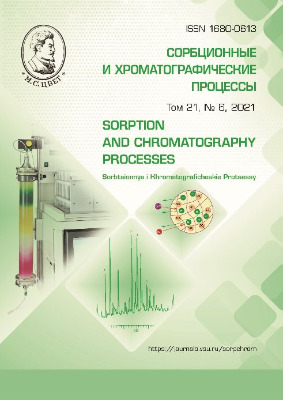Graphical method for detecting changes in chemical structures by the IR spectra of solid-phase drugs
Abstract
The method for processing narrow areas of IR spectroscopy data after heating pharmaceutical substances and model mixtures based on the analysis of changes in optical density values at maximum points, was proposed. The method is based on a graphical approach for plotting dependencies in the relative optical density – heating temperature coordinates. The method allows to identify in the spectra displacements associated with a change in the structure of a substance under the influence of a stress factor (temperature) based on the analysis of the dependencies. Based on the assumption that the system is two-component, the similarity of the dependences within the experimental error allows to conclude that two components have a significant effect in this range. Significant differences of the dependences indicate the presence of intermolecular processes in the solid phase and an increase in the number of components in the system by more than two. The model mixture was heated to temperatures of 20, 50, 90, and 115оС for 8 h, followed by cooling. The spectrum of a substance at 50оС was selected as a comparison spectrum. Based on the generalization of the results of experimental studies, statistical characteristics of the estimated values of optical density were obtained. Analytical expressions for calculating the standard deviation of the calculated value of the relative optical density were obtained based on the formula of propagation of uncertainty. The analysis of the dependences of the statistical characteristics for various experimental conditions was carried out. The correctness of determination of the appearance of new components in pharmaceutical substances under the influence of stress factors was established. Application of the method in the technological process of using pheniramine maleate allowed to reveal the approximation of the structure of pheniramine maleate to the structure of the main form of pheniramine over the entire range of the characteristic spectrum of tertiary aliphatic nitrogen in the range of wave numbers 1621-1557 cm-1. At the same time, according to the graphical analysis of deviations in the functional group region of the spectrum 930-860 cm-1 it was revealed that the pyridine nitrogen of pheniramine maleate forms an electronic structure different from that which it had in pheniramine maleate and pheniramine. The conclusions on the change in the structure of a substance under the influence of the stress factor of temperature are confirmed by the chemistry of the ongoing processes.
Downloads
References
Kulikov A.L., Golubiczkij G.B., Val-yukevich T.Yu., Budko E.V. et al., Vestnik Moskovskogo universiteta. Seriya 2. Khimi-ya, 2007, Vol. 48, No 3, pp. 178-181.
Matvejchuk Yu.V., Izvestiya vuzov. Khimiya i khimicheskaya tekhnologiya, 2017, Vol. 60, Vy`p. 1, pp. 56-63.
Il`yasov D.S., Il`yasov S.G., Vereshhagin A.L., Polzunovskij vestnik, 2015, No 3, pp. 72-74.
Gredyukhina I.V., Plotnikova L.V., Nechiporenko A.P., Uspenskaya M.V., Izvestiya vuzov. Prikladnaya khimiya i bio-tekhnologiya, 2017, No 4 (23), pp. 132-135.
Eltsova N.O., Budko E.V., Yampol`skij L.M., Kulikov A.L., Sorbtsionnye i khromatograficheskie protsessy, 2016, Vol. 16, No 5, pp. 719-723.
Eltsova N.O., Budko E.V., Sorbtsionnye i khromatograficheskie protsessy, 2019, Vol. 19, No 4, pp. 474-480.
Budko E.V, Golubiczkij G.B., El`czova N.O., Zhurnal analiticheskoj khimii, 2014, Vol. 69, No 10, pp. 1-13.
Gabrielsson J., Lindberg N-O., Gabrielsson J., Lundstedt T. et al., Journal of chemometrics, 2002, No 16, pp. 141-160.
Szymanska-Chargot M. Zdunek A., Food Biophysics, 2013, No 8, pp. 29-42.
Cherepanov I.S., Polzunovskij vestnik, 2019, No 1, pp. 137-141.
Savel`ev D.S., Islyajkin M.K., Girichev G.V., Izvestiya vuzov. Khimiya i khimicheskaya tekhnologiya, 2016, No 3, pp. 35-42.
Surov O.V., Krest`yaninov M.A., Mamardashvili N.Zh., Izvestiya vuzov. Khimiya i khimicheskaya tekhnologiya, 2016, No 5, pp. 30-36.
Nazarov N.I., Beknazarov Kh.S., Raz-zoқov Kh.K., Nazarov S.I., Universum: tekhnicheskie nauki, 2020, No 11-3 (80), pp. 93-97.
Abdurakhmonov S.F., Umarov B.B., Khudoyarova E.A., Universum: khimiya i biologiya, 2020, No 10-2 (76), pp. 5-9.
Rudakov O.B., Polyanskaya N.K., Bajdicheva O.V., Selemenev V.F. et al., Zhurnal analiticheskoj khimii, 2009, Vol. 64, No 5, pp. 506-510.
Bershtejn I.Ya. Kaminskij Yu.L. Spektrofotometricheskij analiz v organicheskoj khimii. Leningrad. Khimiya, 1986, 200 p.
Pokrovskij M.V., Boby`nczev I.I., Korokin M.V., Semochkina E.A. et al., Kurskij nauchno-prakticheskij vestnik chelovek i ego zdorov`e, 2007, No 4, pp. 22-29.
Budko E.V. El`czova N.O., Zavodskaya laboratoriya. Diagnostika materialov, 2019, No 9, pp. 79-83.
Gosudarstvennaya farmakopeya Ros-sijskoj Federaczii – 12-e izd. Minzdravsocz-razvitiya Rossii, 2008, 704 p.







